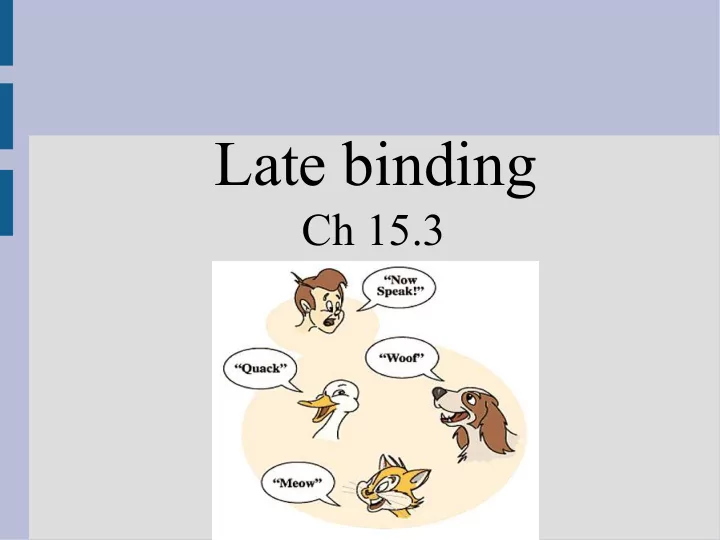

Late binding Ch 15.3
Highlights - Late binding for variables
Review: Derived classes Today we will deal more with inheritance Mainly we will focus on how you can store a child class in a parent container (sort of) Questions we will answer: What is this line of code doing exactly? Are there other ways of doing this?
Early vs late binding Static binding (or early) is when the computer determines what to use when you hit the compile button Dynamic binding (late) is when the computer figures out the most appropriate action when it is actually running the program Much of what we have done in the later parts of class is similar to late binding
Static binding When you go to a fast-food-ish restaurant, you get one tray, regardless of what you order The key is before they knew what you were ordering, they determined you needed one tray
Dynamic binding When you order a drink, they do not just give you a standard cup and say “fill to this line” Now, they have to react to what you want and give you the correct cup size (not a predetermined action, thus dynamic binding)
Static binding Checking out at a grocery store, all items are scanned and added to the bill in the same way The same program on the computer runs for all items and just identifies their price
Dynamic binding After you pay, you put the food into bags (paper/plastic/your own) Both What items go where depends on what you want to use and the item properties (weight, dampness, rigidness, etc.)
Static/dynamic binding All animals need to mate, so we could build a generic Animal class with a function mate() However, the gender roles in mate() are very different between species... snack caring
Static/dynamic binding Consider this code: You know the output even before the program runs (you know at compile time = static) While this code, you only know the output when the program runs (i.e. dynamic): (See: compleVsRun.cpp)
Static/dynamic binding static = rigid/constant dynamic = flexible/adaptive
Static/dynamic binding Static/dynamic binding is similar to how we originally made arrays: (static/early binding) To dynamic memory arrays: (dynamic/late)
Mini-quiz (ungraded) What is in p at end of main()? 1. x=2 2. x=2, y=10 3. x=1, y=10 4. x=1 (Hint: what happens on this:)
= between parent/child It is debatable how we should interpret line: In C++ (not some other languages), this just copies the parts of the parent class over Parent Parent = int x = 2 int x = 2 p Child int y = 10 c
Mini-quiz (ungraded) What is at p now? 1. x=2 2. x=2, y=10 3. x=1, y=10 4. x=1
= between parent/child pointers When the objects are pointers, lines line just changes the object being pointed to (but not any information inside either class) Parent Parent int x = 1 int x = 2 Child Parent* Child* = int y = 10 go go p c
Dynamic variable binding If a Parent type is pointing to a Child instance, we cannot directly access them (variables cannot be “virtual”...) Instead, we have to tell it to act like a Child* by casting it: (bad practice as y public) (see: dynamicObject.cpp) (see: whatMyType.cpp)
Dynamic variable binding If p points to a Parent instance, the below line is VERY BAD (but it might work... sorta...) You will be fooling around in some part of memory that is not really associated p (though you might not crash...) (see: badMemoryManagement.cpp) (see: memoryOops.cpp)
Recommend
More recommend